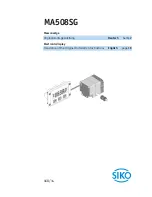
Design and function
© Festo Didactic
8154245 en
35
6.5
Assignment
The CP application module Measuring is designed for recording and rating a quantitative characteristic
value. In this connection, the difference in length measured by differential measurement represents the
metrically scaled continuous feature. Besides, the value of the difference in length corresponds to the
quantitative characteristic value, in the following referred to as the measured value of difference.
By determining a quality requirement such as, for instance, the production tolerances of the workpiece, its
position on the carrier etc., a rating can be performed by means of the recorded characteristic value and the
limit value range defined for the quality requirement.
The result of the rating can be shown with a signal lamp, thus influencing the further value-added process of
the workpiece, for example:
•
result without the defined limit value range
reaction: identifying the workpiece as a bad part and sorting it out, or forwarding it for further
processing
•
result within the defined limit value range:
reaction: identifying the workpiece as a good part and forwarding it to the next processing station
NOTE
–
Due to local views, the differential measurement will also be referred to as
height measurement in what follows.
6.6
Function
NOTE
–
The CP application module measuring has exclusively been constructed for
differential measurements.
The CP application module Measuring has been constructed for controlling the quality of housing parts. It
has got two distance sensors working with the triangulation method. Triangulation method means that the
laser (light source) and the optical position sensor (detector) are positioned in a certain defined distance to
each other. The beam path of the laser meets an object and is reflected by this object into the direction of
the optical position sensor. The distance between the laser and the object is automatically calculated on the
basis of the light spot
’s position on the optical position sensor
.
Teaching the distance sensors according to the relevant measuring area is required. They emit the
corresponding distance to an object in their measuring area as an analogue signal. The scan points of the
distance sensors BG2 (1) and BG3 (3) are directed to two different measuring zones on the workpiece (2).
Teaching the measuring areas of the distance sensors during commissioning to an area from the topside of
the workpiece reception (5) up to 40 mm above it (4) has to be done. Thus the difference (A) is 40 mm.
Therefore, the distance sensors emit their minimum analogue signal with an idle pallet, and they emit their
maximum analogue signal with an object on a pallet that with a height of 40 mm. The station Measuring
reads the two analogue signals and calculates the actual measured value of difference (characteristic value)
from that.
Summary of Contents for CP-AM-MEAS
Page 20: ...Basic safety instructions 20 Festo Didactic 8154245 en 4 11 CE Declaration of Conformity ...
Page 21: ...Basic safety instructions Festo Didactic 8154245 en 21 ...
Page 22: ...Basic safety instructions 22 Festo Didactic 8154245 en ...
Page 26: ...Technical data 26 Festo Didactic 8154245 en Illustration similar ...
Page 37: ...Design and function Festo Didactic 8154245 en 37 6 6 1 Measuring chain CP Lab ...
Page 39: ...Design and function Festo Didactic 8154245 en 39 6 6 2 Measuring chain CP Factory ...
Page 69: ...Operation Festo Didactic 8154245 en 69 3 Change to Setup mode page 4 Choose application ...
















































